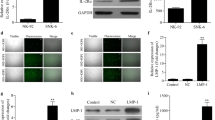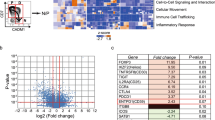Abstract
High Mobility Group Chromosomal Protein N2 (HMGN2) can recognize tumor cells and enhance the anti-tumor effect of immune cells. This study aimed to establish a lentiviral vector of recombinant HMGN2 gene, establish recombinant T cells (HMGN2-T cells), and observe their anti-tumor effects. Total RNA was isolated from peripheral blood mononuclear cells. HMGN2, cluster of differentiation (CD) 8 A, CD28, CD137, and CD3ζ genes were amplified and connected. Jurkat cells were transfected with the recombinant lentivirus vector. The viability, apoptosis, and cell cycle of HMGN2-T cells were detected using Cell Counting Kit-8 assay and flow cytometry. The co-culture was performed by adding HMGN2-T cells to tumor cells with different effect-to-target (E:T) ratios. The cytotoxic activity was measured by lactate dehydrogenase (LDH) releasing assay. The sequences of HMGN2, CD8A, CD28, CD137, and CD3ζ gene plasmids were confirmed using gene sequencing. After the lentiviral transfection for 72 h, green fluorescence cells (HMGN2-T cells) could be seen. Cell viability and apoptosis were increased in HMGN2-T cells. The cytokine levels of interleukin 2 (IL-2) and tumor necrosis factor α (TNF-α) increased in cell supernatants of HMGN2-T cells. The percentage of G0/G1 phase cells was lower, the rate of S phase cells was higher in HMGN2-T cells than control cells. The co-culture of HMGN2-T cells and tumor cells could promote the cytokines’ release. The LDH level was increased with the elevation of E:T ratios. In conclusion, the HMGN2-T cells were well-established and have the effect of secreting cytokines and killing tumor cells.




Similar content being viewed by others
Data Availability
The datasets used and/or analyzed during the current study are available from the corresponding author on reasonable request.
Abbreviations
- CIK:
-
Cytokine-induced killer
- NK:
-
Natural killer
- CD:
-
Cluster of differentiation
- LAK:
-
Lymphokine-activated killer
- TCR:
-
T cell receptor
- CAR:
-
Chimeric antigen receptor
- HMGN2:
-
High Mobility Group Chromosal Protein N2
- PBMC:
-
Peripheral blood mononuclear cell
- EDTA:
-
Ethylene Diamine Tetraacetic Acid
- PBS:
-
Phosphate buffer saline
- CCK-8:
-
Cell Counting Kit-8
- ATCC:
-
American Type Culture Collection
- FBS:
-
Fetal bovine serum
- IL-2:
-
Interleukin 2
- IFN-γ:
-
Interferon γ
- TNF-α:
-
Tumor necrosis factor α
- ELISA:
-
Enzyme-Linked Immunosorbent Assay
- LDH:
-
Lactate dehydrogenase
- SD:
-
Standard deviation
- ANOVA:
-
Analysis of variance
References
Chen J, Fan Y, Cui B, Li X, Yu Y, Du Y et al (2018) HMGN2: An Antitumor Effector Molecule of γδT Cells. J Immunother 41(3):118–124. doi:https://doi.org/10.1097/cji.0000000000000211
Cui W, Liu Y, Tan Y, Peng X, Cui L, Cheng Z et al (2021) Prognostic value of HMGN family expression in acute myeloid leukemia. Future Oncol 17(5):541–548. doi:https://doi.org/10.2217/fon-2020-0555
Fan B, Shi S, Shen X, Yang X, Liu N, Wu G et al (2019) Effect of HMGN2 on proliferation and apoptosis of MCF-7 breast cancer cells. Oncol Lett 17(1):1160–1166. doi:https://doi.org/10.3892/ol.2018.9668
Feng Y, Yang H, Huangning, Wu Q, Bao L, Wang B (2005) [E. coli-based production of recombinant HMG-17 and its antibacterial domain]. Sheng Wu Yi Xue Gong Cheng Xue Za Zhi 22(4):773–777
Ferrall L, Lin KY, Roden RBS, Hung CF, Wu TC (2021) Cervical Cancer Immunotherapy: Facts and Hopes. Clin Cancer Res. doi:https://doi.org/10.1158/1078-0432.Ccr-20-2833
Goodwin GH, Sanders C, Johns EW (1973) A new group of chromatin-associated proteins with a high content of acidic and basic amino acids. Eur J Biochem 38(1):14–19. doi:https://doi.org/10.1111/j.1432-1033.1973.tb03026.x
Grupp SA, Kalos M, Barrett D, Aplenc R, Porter DL, Rheingold SR et al (2013) Chimeric antigen receptor-modified T cells for acute lymphoid leukemia. N Engl J Med 368(16):1509–1518. doi:https://doi.org/10.1056/NEJMoa1215134
Hu A, Dong X, Liu X, Zhang P, Zhang Y, Su N et al (2014) Nucleosome-binding protein HMGN2 exhibits antitumor activity in oral squamous cell carcinoma. Oncol Lett 7(1):115–120. doi:https://doi.org/10.3892/ol.2013.1665
Janka GE (2012) Familial and acquired hemophagocytic lymphohistiocytosis. Annu Rev Med 63:233–246. doi:https://doi.org/10.1146/annurev-med-041610-134208
Jotereau F, Pandolfino MC, Boudart D, Diez E, Dreno B, Douillard JY et al (1991) High-fold expansion of human cytotoxic T-lymphocytes specific for autologous melanoma cells for use in immunotherapy. J Immunother (1991), 10(6), 405–411. doi:https://doi.org/10.1097/00002371-199112000-00003
Kalager M, Adami HO, Lagergren P, Steindorf K, Dickman PW (2021) Cancer outcomes research - a European challenge Measures of the cancer burden. Mol Oncol. doi:https://doi.org/10.1002/1878-0261.13012
Kumar A, Swain CA, Shevde LA (2021) Informing the new developments and future of cancer immunotherapy: Future of cancer immunotherapy. Cancer Metastasis Rev. doi:https://doi.org/10.1007/s10555-021-09967-1
Li Q, Chen J, Li X, Cui B, Fan Y, Geng N et al (2018) Increased expression of high-mobility group nucleosomal-binding domain 2 protein in various tumor cell lines. Oncol Lett 15(4):4517–4522. doi:https://doi.org/10.3892/ol.2018.7898
Maus MV, Haas AR, Beatty GL, Albelda SM, Levine BL, Liu X et al (2013) T cells expressing chimeric antigen receptors can cause anaphylaxis in humans. Cancer Immunol Res 1:26–31
Morris EC, Neelapu SS, Giavridis T, Sadelain M (2021) Cytokine release syndrome and associated neurotoxicity in cancer immunotherapy. Nat Rev Immunol. doi:https://doi.org/10.1038/s41577-021-00547-6
Motohashi K (2019) A novel series of high-efficiency vectors for TA cloning and blunt-end cloning of PCR products. Sci Rep 9(1):6417. doi:https://doi.org/10.1038/s41598-019-42868-6
Porter DL, Levine BL, Kalos M, Bagg A, June CH (2011) Chimeric antigen receptor-modified T cells in chronic lymphoid leukemia. N Engl J Med 365(8):725–733. doi:https://doi.org/10.1056/NEJMoa1103849
Sasada T, Suekane S (2011) Variation of tumor-infiltrating lymphocytes in human cancers: controversy on clinical significance. Immunotherapy 3(10):1235–1251. doi:https://doi.org/10.2217/imt.11.106
Su L, Hu A, Luo Y, Zhou W, Zhang P, Feng Y (2014) HMGN2, a new anti-tumor effector molecule of CD8+ T cells. Mol Cancer 13:178. doi:https://doi.org/10.1186/1476-4598-13-178
Thomas DA, O’Brien S, Faderl S, Garcia-Manero G, Ferrajoli A, Wierda W et al (2010) Chemoimmunotherapy with a modified hyper-CVAD and rituximab regimen improves outcome in de novo Philadelphia chromosome-negative precursor B-lineage acute lymphoblastic leukemia. J Clin oncology: official J Am Soc Clin Oncol 28(24):3880–3889. doi:https://doi.org/10.1200/jco.2009.26.9456
Wang Q, Liu H, Zhang X, Liu Q, Xing Y, Zhou X et al (2010) High doses of mother’s lymphocyte infusion to treat EBV-positive T-cell lymphoproliferative disorders in childhood. Blood 116(26):5941–5947. doi:https://doi.org/10.1182/blood-2010-01-262311
Wang X, Yu W, Li H, Yu J, Zhang X, Ren X et al (2014) Can the dual-functional capability of CIK cells be used to improve antitumor effects? Cell Immunol 287(1):18–22. doi:https://doi.org/10.1016/j.cellimm.2013.11.009
Wei D, Zhang P, Zhou M, Feng Y, Chen Q (2014) HMGN2 protein inhibits the growth of infected T24 cells in vitro. J Cancer Res Ther 10(2):299–304. doi:https://doi.org/10.4103/0973-1482.136577
Xiao Q, Li X, Li Y, Wu Z, Xu C, Chen Z et al (2021) Biological drug and drug delivery-mediated immunotherapy. Acta Pharm Sin B 11(4):941–960. doi:https://doi.org/10.1016/j.apsb.2020.12.018
Acknowledgements
None.
Funding
None.
Author information
Authors and Affiliations
Corresponding authors
Ethics declarations
Competing interests
All authors declare that they have no competing interests.
Additional information
Publisher’s Note
Springer Nature remains neutral with regard to jurisdictional claims in published maps and institutional affiliations.
Electronic supplementary material





Rights and permissions
About this article
Cite this article
Li, H., Wu, X., Bu, D. et al. Recombinant jurkat cells (HMGN2-T cells) secrete cytokines and inhibit the growth of tumor cells. J Mol Histol 53, 741–751 (2022). https://doi.org/10.1007/s10735-022-10084-8
Received:
Accepted:
Published:
Issue Date:
DOI: https://doi.org/10.1007/s10735-022-10084-8




